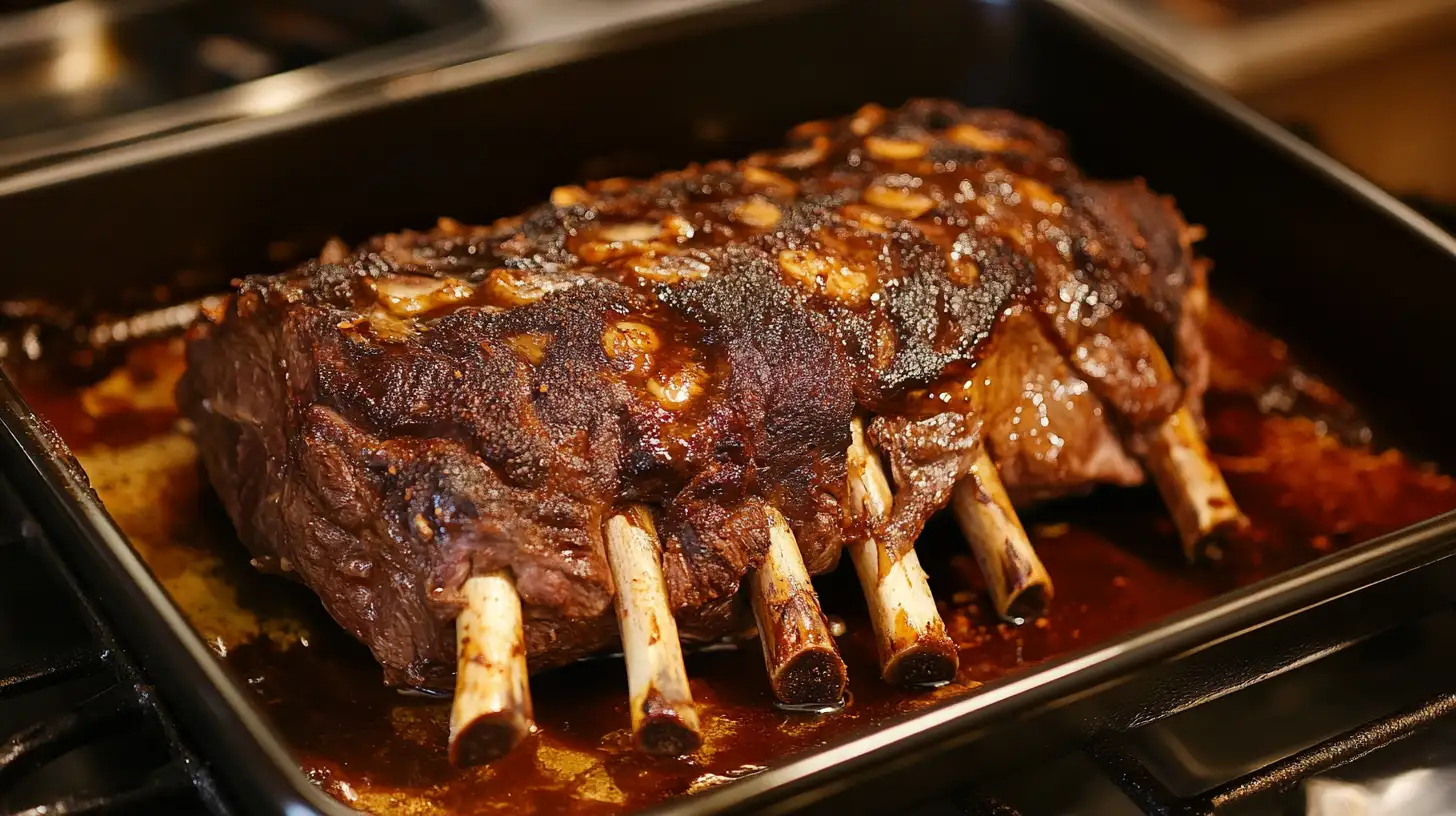Introduction to Elk Roast Recipe
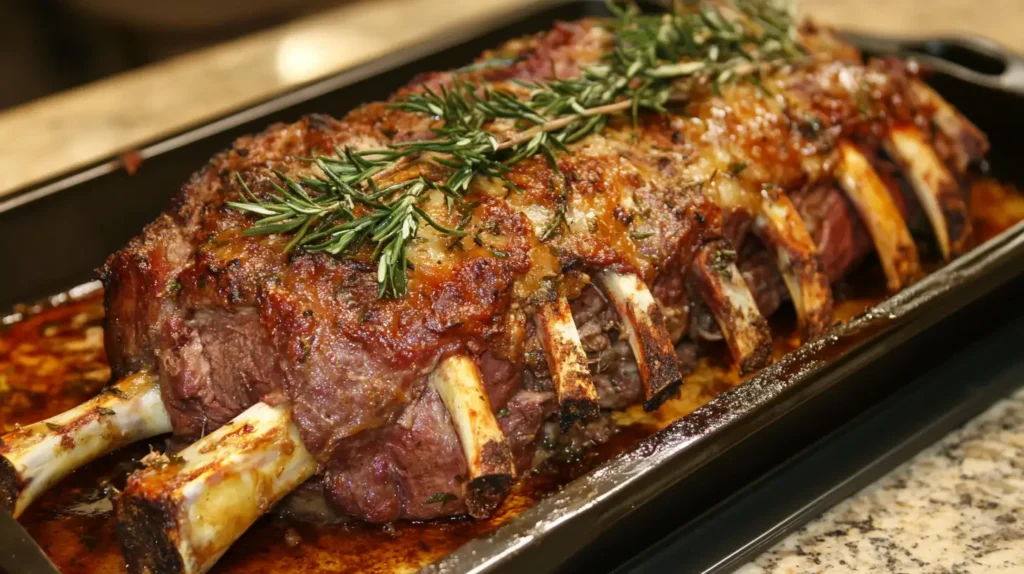
What is an Elk Roast Recipe?
An elk roast recipe is a large cut of elk meat, typically from the shoulder or rump, cooked slowly to achieve tenderness and maximize its rich, earthy flavor. Known for its lean texture and robust taste, elk roast is often paired with vegetables, herbs, and sauces to create a hearty and satisfying meal. It’s a favorite among wild game enthusiasts, celebrated for its ability to adapt to various cooking techniques such as braising, roasting, or slow cooking.
History of Elk as a Culinary Delight
Elk has been a staple in North American cuisine for centuries, dating back to indigenous communities that relied on elk for sustenance. With its abundance in the wild, elk provided not only food but also materials for clothing and tools. Over time, elk transitioned from a necessity to a culinary delight, particularly in regions known for hunting traditions like the Rocky Mountains and the Midwest. Today, elk is revered for its distinctive flavor and sustainable appeal, gracing the tables of chefs and home cooks alike.
Why Choose Elk Over Other Meats?
Elk stands out as a healthier, more sustainable alternative to conventional meats like beef or pork. Here’s why:
- Lean and Nutritious: Elk is high in protein, iron, and omega-3 fatty acids while being low in fat and calories, making it a heart-healthy option.
- Sustainable and Ethical: Most elk meat comes from wild or farmed animals raised in natural environments, making it a more ethical choice for conscientious consumers.
- Unique Flavor Profile: Elk’s mild, slightly sweet taste is less gamey than venison and pairs beautifully with various herbs, spices, and sauces.
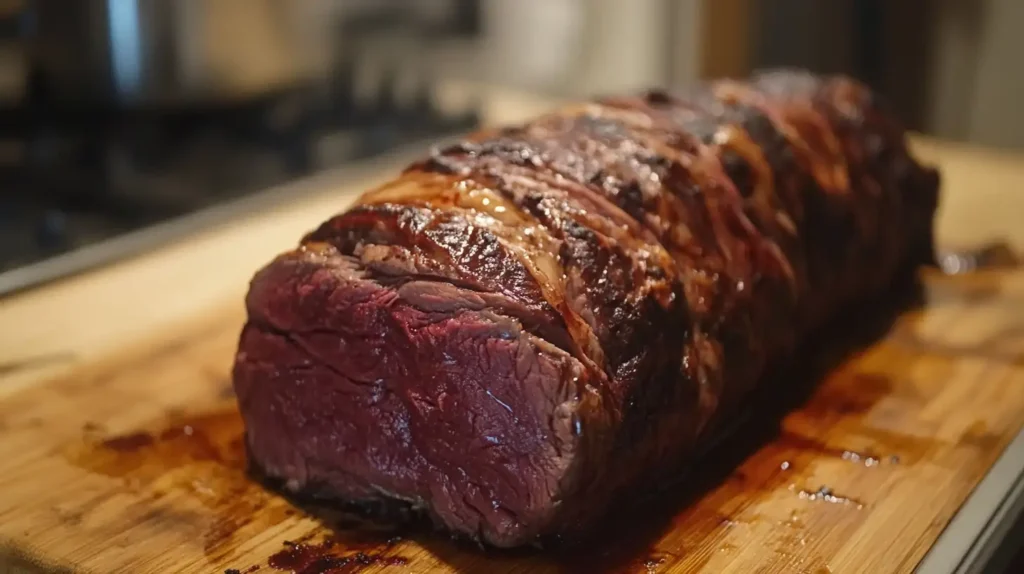
Choosing elk not only supports sustainable practices but also allows you to experience a premium cut of meat with unparalleled nutritional benefits. Whether you’re a seasoned wild game enthusiast or new to elk, an elk roast is a delicious introduction to the world of game meats.
Nutritional Benefits of Elk Roast Recipe
Low Fat and High Protein Content
Elk meat is prized for its exceptionally lean profile and high protein content, making it a standout choice for health-conscious eaters. A standard serving of elk contains:
- Less fat than beef, pork, or lamb, making it a heart-friendly option.
- Approximately 23 grams of protein per 3-ounce serving, supporting muscle growth and repair. This balance of low fat and high protein makes elk meat a powerhouse for athletes, fitness enthusiasts, and anyone seeking a nutrient-dense meal.
Essential Vitamins and Minerals
Elk meat is rich in a variety of essential nutrients, including:
- Iron: Promotes healthy red blood cells and combats fatigue.
- Zinc: Supports immune function and aids in healing wounds.
- B vitamins (B12, B6): Vital for energy production, brain health, and nerve function.
- Omega-3 fatty acids: Found in elk meat from wild or grass-fed animals, contributing to heart and brain health. These nutrients make elk a wholesome option for boosting overall health while enjoying a flavorful meal.
Comparison with Beef and Other Game Meats
When compared to other meats, elk comes out on top in several key areas:
- Lower in fat than beef and pork, with comparable or greater protein content.
- Milder in flavor than venison, making it appealing to those new to game meats.
- Higher nutrient density compared to beef, offering more iron and fewer calories per serving. Elk also provides a cleaner and leaner alternative to farm-raised meats, as it’s often sourced from animals raised in natural or wild settings.
Choosing elk meat is not just about taste—it’s a commitment to nutrition and sustainability. It delivers all the benefits of lean protein while offering unique flavors and an impressive nutritional profile.
Why Elk Meat?
Elk meat is a fantastic choice for anyone seeking a healthier alternative to beef. Packed with protein, low in fat, and rich in essential nutrients like iron and omega-3s, elk meat is both versatile and flavorful. Its mild, slightly sweet taste also makes it a favorite for roasts, stews, and steaks.
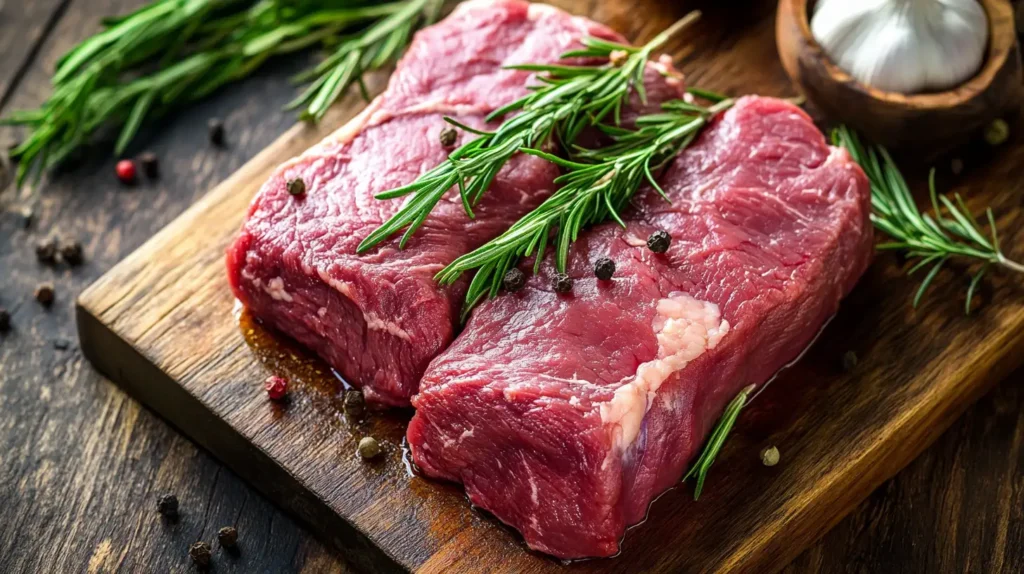
If you’re exploring additional lean meat options, consider browsing sustainable meal ideas like sourdough-based recipes. These recipes complement the natural flavors of elk without overpowering them.
Ingredients You’ll Need for Elk Roast Recipe
To create the perfect elk roast, gather the following ingredients:
- 3 lbs elk roast (substitute with venison or moose if unavailable)
- 3 strips of bacon, cut into pieces
- 1 onion, chopped
- 3 cloves garlic, minced
- 1 cup mushrooms, sliced
- 1/2 cup beef broth
- 1/2 cup red wine
- Fresh rosemary and thyme
- Salt and pepper to taste
For a fun twist, explore ways to use seasonal herbs and spices in your dish, as featured in these French onion-inspired recipes.
Preparing Elk Roast Recipe: Pre-Cooking
Defrosting and Marinating Techniques
Proper preparation starts with defrosting and marinating to ensure your elk roast is both tender and flavorful:
- Defrosting: Thaw elk meat in the refrigerator overnight for even defrosting. Avoid microwave defrosting, as it can lead to uneven cooking and a loss of moisture.
- Marinating: Use marinades with acidic ingredients like red wine, vinegar, or citrus juice to break down the meat fibers and enhance flavor. Combine with olive oil, garlic, and herbs like rosemary or thyme for a robust marinade. Allow the elk roast to soak for at least 4–6 hours, or overnight for maximum tenderness.
Tools You’ll Need
Preparation is easier with the right tools:
- Sharp chef’s knife for trimming silver skin.
- A sturdy cutting board.
- A large bowl or resealable bag for marinating.
- Meat thermometer to ensure perfect doneness.
Having these items ready ensures a smooth cooking process and helps you achieve the best results.
Tips for Tenderizing Elk Meat
Elk meat’s lean nature requires special care to achieve a tender roast:
- Remove Silver Skin: Trim away the thin connective tissue known as silver skin. It doesn’t break down during cooking and can make the meat tough.
- Pound the Roast: Use a meat mallet to gently break down the muscle fibers, especially if the cut is thicker.
- Soak or Brine: Soaking the meat in a saltwater brine for 1–2 hours before cooking can help retain moisture and reduce any gamey flavors.
- Cook Low and Slow: Preparing elk roast with slow cooking techniques like braising or crockpot cooking allows the natural juices to infuse the meat, keeping it moist and tender.
Following these pre-cooking techniques ensures your elk roast is perfectly prepared for a flavorful and tender final dish.
Step-by-Step Cooking Instructions
Preparation
- Trim the Meat
Remove the silver skin to reduce any gamey flavor. If time allows, drain the roast overnight in a colander to remove excess blood. - Season Generously
Rub the roast with a mixture of kosher salt and freshly ground pepper. A generous seasoning layer creates a flavorful crust during cooking. - Brown the Meat
For added depth of flavor, brown the elk roast in bacon grease before cooking. This step, known as the Maillard reaction, enhances the meat’s richness.
Cooking Methods
Instant Pot
- Add bacon to the pot and cook until crispy.
- Sear the elk roast in the bacon fat.
- Add garlic, onions, mushrooms, broth, and wine.
- Pressure cook for 45 minutes, then check tenderness.
Crockpot
- Layer bacon and vegetables at the bottom of the pot.
- Place the roast on top and add liquid ingredients.
- Cook on low for 8–10 hours or until the meat is fork-tender.
Oven
- Preheat the oven to 275°F.
- Sear the roast, add liquids and vegetables, then cover tightly.
- Braise for 3–4 hours.
Pairing Sides with Elk Roast
Best Vegetables to Serve Alongside
Elk roast pairs beautifully with an array of vegetables that enhance its rich, earthy flavors. Some of the best options include:
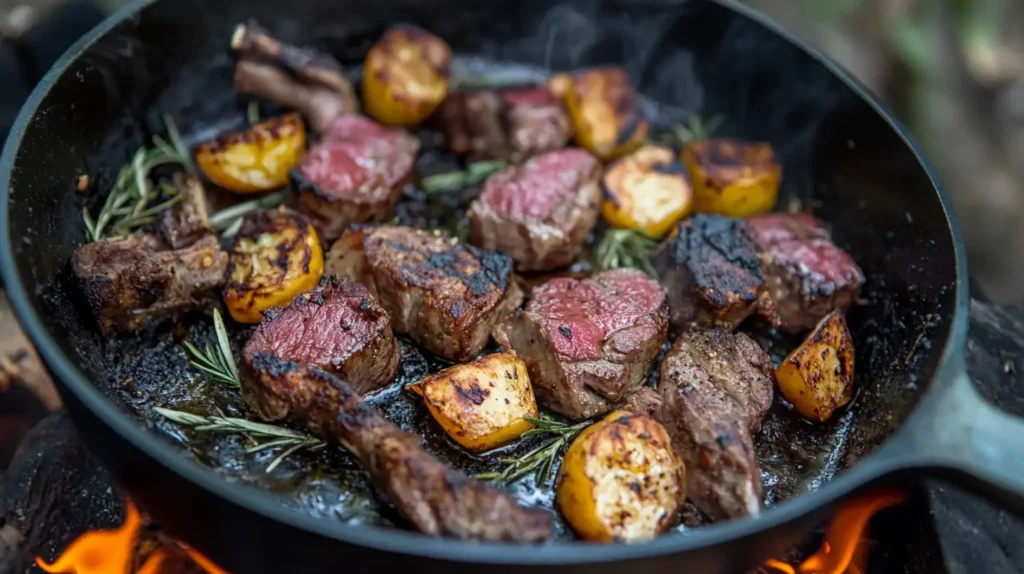
- Root Vegetables: Roasted carrots, parsnips, and sweet potatoes add a natural sweetness that balances the meat’s robust taste. For more vegetable-forward ideas, check out Dutch oven camping recipes for inspiration.
- Leafy Greens: Sautéed spinach, kale, or a fresh mixed green salad provides a refreshing contrast to the hearty roast.
- Seasonal Favorites: Asparagus, Brussels sprouts, or roasted squash bring a delightful seasonal flair to the table.
For a classic pairing, garlic mashed potatoes or buttery mashed cauliflower make excellent sides to soak up the rich gravy.
Complementary Sauces and Gravies
The right sauce or gravy transforms your elk roast into a truly gourmet dish. Options include:
- Classic Pan Gravy: Use the roast’s drippings, deglazed with wine or broth, and thickened with cornstarch or flour.
- Red Wine Reduction: Elevate your roast with a sophisticated reduction that brings out its natural richness.
- Herb-Infused Sauces: Rosemary or thyme butter sauces add a fragrant, savory touch.
For a unique twist, try pairing your roast with a cranberry or juniper berry compote. To explore more sauce ideas, visit our collection of country-style beef ribs recipes for inspiration.
Ideal Wines and Beverages
Elk roast’s bold flavors call for equally robust beverages:
- Red Wines:
- Cabernet Sauvignon: Its full-bodied profile enhances the roast’s earthy tones.
- Pinot Noir: A lighter option with fruity and floral notes.
- Malbec: A robust flavor with a smooth finish, perfect for wild game.
- Beer Pairings: Dark ales or stouts complement the hearty flavors of the roast and gravy.
- Non-Alcoholic Options: Sparkling water with lemon or a robust berry juice offers a refreshing contrast.
Looking to complete your meal with more beverage ideas? Consider pairing it with options inspired by these backpacking recipes for adventurous dining experiences.
Thoughtfully selected sides, sauces, and beverages ensure your elk roast becomes the centerpiece of a truly memorable meal. Each pairing enhances the dish’s flavors, making every bite a delightful experience.
FAQs About Elk Roast Recipe
What is the best way to cook elk?
The best way to cook elk is through slow and gentle methods such as braising, slow cooking, or pressure cooking. These methods ensure the meat becomes tender without overcooking. For quick options, grilling or pan-searing thin cuts of elk steak works well, but for a roast, methods like using a crockpot or instant pot are ideal to retain moisture and enhance flavor.
Is elk roast tough?
Elk roast can be tough if cooked incorrectly. Because elk meat is lean with little fat, overcooking can lead to dryness and a chewy texture. Slow cooking at low temperatures or braising in liquid helps break down connective tissue, resulting in a tender roast. Proper seasoning and marinating can also help soften the meat.
What temperature should elk roast be cooked at?
For an elk roast, cook at a low oven temperature of 275°F (135°C) if braising or roasting, to retain moisture over a longer period. When using a meat thermometer, aim for an internal temperature of:
- 130°F to 140°F for medium-rare
- 150°F for medium
Avoid cooking beyond medium to preserve the meat’s natural tenderness.
What is the best seasoning for elk?
Elk’s mild, slightly sweet flavor pairs beautifully with herbs and spices. The best seasonings include:
- Fresh rosemary and thyme for earthiness
- Garlic and onion powder for depth
- Smoked paprika or cayenne for a slight kick
- Kosher salt and cracked pepper to enhance the natural flavor
Consider marinating elk with red wine, olive oil, and herbs for extra tenderness and flavor infusion.
How do you keep elk roast from drying out?
To prevent elk roast from drying out:
- Cook it slowly at low temperatures.
- Use a moisture-retaining method such as braising or slow cooking with broth or wine.
- Wrap the roast in bacon to add fat and flavor.
- Avoid overcooking and always rest the meat for 10 minutes after cooking to redistribute juices.
Is elk healthier than beef?
Yes, elk is healthier than beef in several ways:
- Lower in fat: Elk is a lean protein with significantly less fat than beef.
- Higher in protein: Elk provides more protein per ounce, making it a great option for active lifestyles.
- Rich in nutrients: Elk is packed with iron, zinc, and omega-3 fatty acids, which are essential for maintaining heart health and reducing inflammation.
- Fewer calories: Elk is lower in calories, making it ideal for those seeking a healthier red meat alternative.
This combination of nutrition and flavor makes elk a superior choice for health-conscious individuals.
Conclusion
Cooking an elk roast doesn’t have to be intimidating. With the right preparation and cooking method, you can create a meal that’s as nutritious as it is delicious. Whether served as a family dinner or as part of a holiday feast, this recipe will surely impress. So gather your ingredients and start cooking—your perfect elk roast awaits!
For more hearty recipes and cooking tips, explore backpacking recipes for adventurous chefs. Happy cooking!

